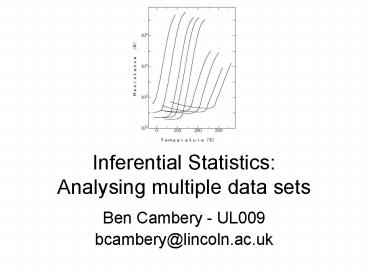Inferential Statistics: Analysing multiple data sets - PowerPoint PPT Presentation
1 / 12
Title:
Inferential Statistics: Analysing multiple data sets
Description:
the formulae are too nasty. What we're looking at. One-Way ANOVA Parametric independent ... Alexandrovich Friedman (1888 1925) (according to Wikipedia.com) ... – PowerPoint PPT presentation
Number of Views:63
Avg rating:3.0/5.0
Title: Inferential Statistics: Analysing multiple data sets
1
Inferential Statistics Analysing multiple data
sets
- Ben Cambery - UL009
- bcambery_at_lincoln.ac.uk
2
What weve done before
- Weve looked at parametric and non-parametric
inferential statistics in relation to comparing
two groups - Today were going to consider testing for three
or more at the same time. - Were NOT going to perform any of these test by
hand the formulae are too nasty.
3
What were looking at
- One-Way ANOVA Parametric independent
- Kruskal Wallis H non-parametric independent
- Freidman test non-paramteric paired
- Well mention Univariate / multivariate ANOVA
the parametric paired test, but its tricky to
implement in SPSS, so not often used
4
ANOVA ANalysis Of VAriance
- This is the one way variant used as described
- This baby is a big, beefy t-test on steroids
- -Niamh Nic Daeid, 2004
- This test is used directly to compare data sets
that are - Normally distributed
- In possession of similar standard deviations
- Ideally interval/ratio and continuous.
5
Demonstration
- Found on SPSS under Compare Means
- Complete data set represents the Dependent List
- Test requires an independent grouping variable or
Factor this is often something like age,
location or so on. - Plug in values and away you go!
6
Kruskal Wallis H test
- The simplest test to use if you want to lie with
data, as nobody knows what it does! - -Ben Cambery, 2005
- Non-parametric comparison of three or more data
sets - Works on pretty much ANY data configuration, save
Nominal data
7
Another Demonstration
- Found in K independent samples under
Nonparametric tests - NOTE K means more than 2
- Place data to be examined in Test variables
- Place grouping variable in Grouping variable
box, then define range to compare - Press OK, and voila!
8
Friedman Test
- Named after its creator, the Russian Cosmologist
Alexander Alexandrovich Friedman (1888 1925)
(according to Wikipedia.com) - Nonparametric test for grouped before and after
data. - Works on the majority of data sets, although each
group should have the same number of values in
the before and after column
9
Yet Another Demo
- Found in Nonparametric tests, under K related
samples - Select groups to compare from list, using the
Ctrl key to multiple select - Click OK to run the test
10
A few notes about Univariate / Multivariate ANOVA
- SPSS could handle it better if you find
yourself needing to play with heavy end ANOVA,
youre best off using Minitab - It resides buried deep in the General Linear
Model tab of SPSS, and requires 2-3 columns of
grouping variables - Friedman tests work on parametric data and are
much simpler to employ
11
Summary
- If your data sets are ordinal, skewed or just
plain awkward, always side for the non-parametric
test! It will give you a more reliable answer.
12
Thats all the stats youre getting!
- The exam covers data types, through correlation
Use of SPSS, questionnaire design and inferential
tests for 3 groups are NOT EXAMINED! - Next week Ill be available for a Q and A at this
time bring your problems and Ill see what I
can do! - Anyone with questionnaire issues, Ill be running
a session at 3pm today in AR1202 - Please keep working through the SPSS booklet it
will help, honest!

